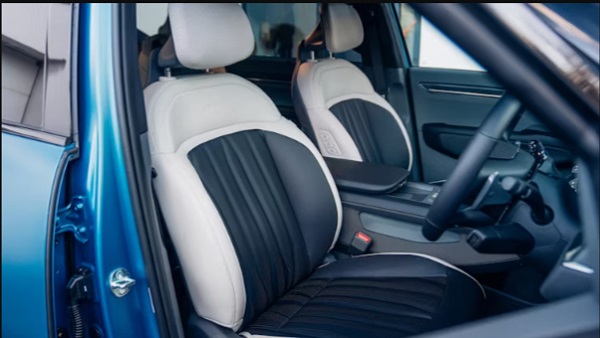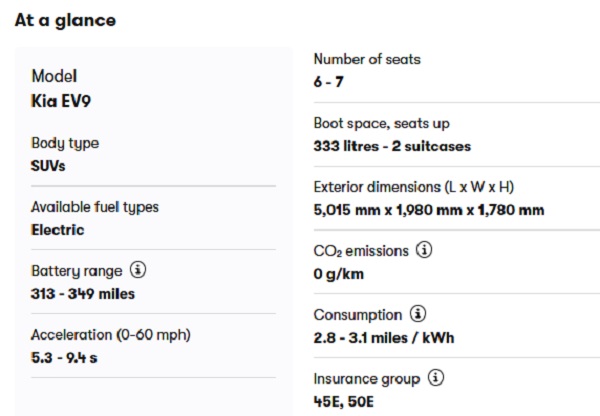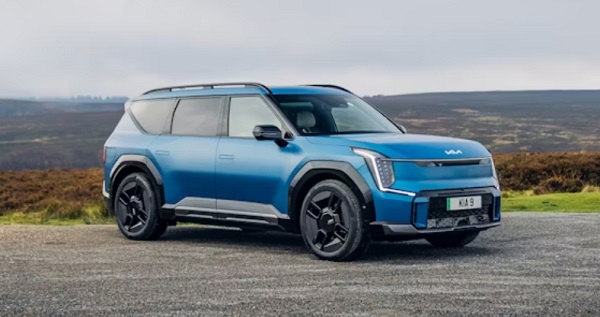The Kia EV9 is an imposing seven-seat SUV with excellent practicality, but it’s not quite posh enough to justify its price tag
Is the Kia EV9 a noteworthy vehicle?
Is larger always superior? When it comes to financial situations and large televisions, the response is affirmative. Does this hold true for electric vehicles as well? The enormous Kia EV9 certainly presents a strong argument – we admire it so much that it won the Outstanding EV category at the 2025 Carwow Car of the Year Awards.
As an electric SUV that seats seven, it’s quite unique. The Volvo EX90 is the only other option on the horizon, although the Tesla Model X is available for those who don’t mind a left-hand drive. If you’re now looking for a large, upscale electric SUV without the seven-seat capacity, you could also think about the Audi Q8 e-tron and BMW iX.
The sizable Kia clearly overshadows its more compact counterpart, the EV6 – if that vehicle is akin to a small commuter plane, the EV9 resembles more of a large airliner. With its roomy and well-furnished interior, it feels like you’re seated in first class.
The interior design is appropriately luxurious and technologically advanced. While twin-screen dashboards are quite popular currently, the EV9 stands out with its three-screen configuration. There are substantial displays for the driver and infotainment system, along with a smaller one positioned between them for climate controls.
However, its placement is suboptimal, as the steering wheel obstructs your view, though you can also adjust it using robust buttons mounted on the dashboard that are easily accessible. Although the EV9 appears upscale within, and the materials you often touch are generally high-quality, it isn’t challenging to spot some less appealing plastics within the dashboard. A similarly priced BMW iX feels more premium inside.

The seats are wonderfully comfortable, and the highest-spec GT-Line models come with fancy reclining seats featuring footrests, even in the front, to maximize relaxation while charging. Additionally, there’s an option for six seats, which consists of second-row seats that can rotate 180 degrees when stationary, allowing you to converse with passengers in the back. This feature can be somewhat awkward and tight if utilized, but it’s an interesting concept nonetheless.
On the other hand, the cargo space is generous. Even with all seven seats up, there’s enough room for several carry-on bags. Fold down the backmost seats, and the cargo area becomes vast, plus there’s a small frunk as well. While the Tesla Model X offers a larger capacity in both areas, very few people will truly require the extra space…
The Kia EV9 demonstrates that large family vehicles can be stylish while still being functional.
All EV9 variants come equipped with the same large battery, which can provide a range of up to 349 miles if you select the long-range single-motor version, or 313 miles if you opt for the more powerful dual-motor variant. The quicker version accelerates to 62mph in 5.3 seconds – quick, but the Tesla Model X surpasses that with its rapid acceleration and has a better range too.
If the Kia’s battery does deplete, you can recharge swiftly due to the EV9’s maximum charging capability of 210kW. There aren’t many high-speed public chargers that can achieve this, but if you find one, Kia states it can recharge from 10-80% in as little as 24 minutes.
One important detail to remember is that the motors are linked to the trim levels; hence, you can’t choose a high-spec model with lower power and increased range, for instance.
When driving, the Kia EV9 is user-friendly. Given the cabin’s spaciousness, it initially feels almost intimidatingly large, but the steering is light and the electric motors very responsive, making it feel quite manageable.
The suspension works better at high speeds, but noticeable jolts occur from sharp, low-speed bumps like potholes, and there’s quite a bit of tire noise from the substantial alloy wheels on the top-spec model. Additionally, undulating country roads can lead to some lateral wobble.
Nevertheless, it generally provides a soothing driving experience for long trips and manages corners quite well for such a sizable and heavy SUV. Some light off-roading did confuse the onboard software, so it might be wise to limit testing the ‘mud’ driving mode.

The idea of spending over £65,000 for a Kia might have seemed absurd not too long ago, yet the EV9 presents a robust argument for itself thanks to its six- or seven-seat configuration and roomy, comfortable interior. It doesn’t quite exude the elegance of certain German rivals within this price range, but it’s notably close, making it an attractive alternative if you desire something less conventional. Plus, it boasts an impressive design. Essentially, this is an MPV disguised as a hefty SUV that consumers are likely to choose.
How much does the Kia EV9 cost?
The Kia EV9 has a recommended retail price ranging from £65,025 to £77,025. However, you can typically save around £2,882 through Carwow. Cash buyers can start at a price of £62,456. Monthly payments begin at £653. The cost for a used Kia EV9 on Carwow starts at £63,995.
As Kia’s flagship model, the EV9 isn’t the most affordable option, yet it is significantly cheaper than both the Volvo EX90 and Tesla Model X. For this price, you could also consider models like the BMW iX and Audi Q8 e-tron – while they don’t offer seven seats, they do have a more premium interior feel.
That said, when you assess the total space and technology available compared to similar vehicles in this price range, a starting cost of £65,000 feels quite reasonable. Just think how different that would have sounded about a Kia a decade ago.
There are three available trim levels; the basic Air model starts at approximately £65,000 and is offered only with a single-motor configuration. For about £10,000 more, you can upgrade to the GT-Line, which includes additional features and a more potent dual-motor setup, while the top-tier GT-Line S models only add around another £3,000. This GT-Line S trim is the sole version that provides the six-seat configuration.
Driving experience and comfort
The Kia EV9 is generally a comfortable ride, though it’s not the most silent electric vehicle when cruising at higher speeds.
In urban settings
It’s clear that the Kia EV9 is a large vehicle, and from the driver’s perspective, the front corners seem quite distant. Thankfully, standard 360-degree cameras help maneuver in tight spaces, such as urban width restrictions.
One potential challenge is its wide turning circle, which can complicate U-turns or navigating tight corners.
The light steering makes the EV9 quite manageable in the city, and overall it’s fairly comfortable; however, hitting a pothole can send a jolt through the cabin, making it less refined than expected.
An interesting feature is the ‘auto’ brake regeneration mode. This utilizes sensors to assess your distance to the vehicle ahead, applying additional braking as you approach for a smooth halt. It also enhances efficiency on the motorway by enabling the car to coast automatically when you release the accelerator.
On the highway
The suspension performs much better at high speeds, and combined with the plush seating, it creates a comfortable environment for long drives. The only drawback is that the larger alloy wheels can generate noticeable tire noise in the cabin, though it’s not overly bothersome. In fact, you feel well-insulated from outside wind noise, which can make you feel as if you’re traveling slower than you are.
With ample power, the all-wheel-drive variant accelerates swiftly and manages the EV9’s weight without any noticeable delay. It’s impressive and perhaps excessive, but it’s still a lot of fun. Merging onto the freeway or making quick overtakes demands little consideration.
On winding roads
Just as in the city, the size of the Kia EV9 remains a constant reminder while driving in rural areas. On narrow roads with trucks approaching, it can feel slightly intimidating, especially while lane-keeping assistance is engaged, as it continually nudges the steering to prevent veering off the road. You might prefer to deactivate this feature, although it requires several button presses that aren’t convenient while driving.
However, when the road opens up and allows for some cornering, the EV9 surprisingly becomes quite entertaining despite its size and weight. Sure, the steering is as detached as we’ve come to expect from electric SUVs, but there is decent traction and ample power to bring joy to your drive.
On particularly hilly country roads, the soft suspension can cause the vehicle to sway side to side, which may lead your passengers to feel a bit queasy if you’re too spirited in your driving…
Space and practicality
The EV9 is a large SUV that offers numerous storage compartments, although some of the nearby storage options could be more spacious.
A long stretch of touchscreen, which consists of three individual displays, takes center stage in the cabin, and the generous size of the EV9 ensures there is ample room for both occupants and belongings throughout the interior.
The driving position is advantageous as you are seated high and have an excellent view of the road ahead; however, those with long legs may wish the steering wheel could be positioned a bit closer.
The center storage area includes a pair of adequately sized cupholders that can swivel away when not in use, creating a larger storage space, and there is an expansive bin at the floor level between the front seats. The glove compartment is quite spacious as well, although the door pockets are somewhat less practical but can accommodate a large bottle; however, they aren’t lined, resulting in smaller items rattling around while driving. The under-armrest storage is also fairly limited in depth.
Once you’re settled into the large front seats, which is not a challenging task, you’ll notice a couple of USB-C chargers and a 12V socket in the front. The seats come with power adjustments across all specifications, although the steering column is manually adjustable in the base Air trim, while higher trims feature memory front seats as standard.

Space in the back seats
The experience in the middle row varies significantly depending on whether you choose the six-seat or the more typical seven-seat configuration.
Opting for the six-seater, which is only available on the top-spec GT-Line S model for approximately £1,000 more than the seven-seater, slightly restricts your ability to carry additional passengers, but there are benefits. Not only can you walk between the two middle seats to access the back row instead of having to climb over, but you also get innovative swivel seats that can rotate.
This means you can turn them 90 degrees for convenient baby seat loading and rotate them 180 degrees for a conference-style setup that enables four people to face each other in the rear. However, there isn’t much knee space available when you do this, and it can be tricky to create enough space between the front seats in order to swing them around. In essence, it isn’t on par with the premium luxury transport offered by a Mercedes V-Class, but it’s still an interesting feature.
If you select the seven-seater, you obviously gain an additional seat. The rear bench splits 60:40 and slides on rails, allowing you to adjust how much legroom is available to second and third-row passengers, and it can be easily folded down at the push of a button for access to the third row. The central middle passenger has the least favorable seating position; this seat is slightly firmer, narrower, and sits a bit higher compared to those flanking it, though at least the flat floor makes it easy to accommodate three pairs of feet in that area. The outer passengers will comfortably fit their feet under the front seats, making it a fairly pleasant place to sit. When the middle seat is unoccupied, the armrest has a ratcheted adjustment so you can choose the height, and it includes two cupholders.
Both front seats come with USB-C charging ports positioned at the back for middle-row passengers, but the rear door pockets are small, making it handy to have access to two cupholders between the front seats. Higher-end models feature a glass roof that gives the rear a bright and airy feel, although it’s disappointing that this isn’t at least an optional feature on the lower trim levels.
Kia has also considered the needs of third-row passengers, providing them with two more USB-C chargers and a cupholder each, although the third-row feels more spacious in the six-seater compared to the seven-seater, due to the space between the seats in front. Nevertheless, it’s possible to fit three six-foot individuals one behind the other in both configurations relatively comfortably.
Access to both rows is facilitated by the wide and large-opening rear doors, which also makes it easier to install a child seat (even if you have the seven-seater and cannot spin the second-row seats). Additionally, there are ISOFIX mounting points in the third row for enhanced child seat installation capability.
Boot space
The Kia EV9 offers 333 liters of boot space even with all three rows of seats in position, which is slightly more than the Volvo EX90, although the Tesla Model X provides more at 425 liters.
When the third row of seats is folded down, the space expands to a substantial 828 liters, making the EV9 appealing for its practicality, even if you don’t require the extra seats. This is significantly more than the 650 liters available in the EX90, while the Audi Q8 e-tron and BMW iX provide 569 liters and 500 liters respectively. However, the Tesla surpasses them all with a capacity of 987 liters.
It’s convenient that the parcel shelf can be stored under the boot floor when all seven seats are in use, although it’s unfortunate that there’s not really a designated area in the back for storing the charging cables. These need to be placed in the front luggage area under the bonnet if you want to keep them separate from your luggage. This area has a capacity of 90 liters in Air models and 50 liters in GT-Line versions, but once again, the Model X takes the lead with its generous 180-liter front boot.
The second row of seats can be folded down by pressing a button located in the boot, creating a spacious area when fully collapsed. Additionally, there is a three-pin socket in the boot that enables charging or powering external devices when parked.
In terms of interior design, style, and features, there are appealing elements regarding the cabin’s aesthetics and feel; however, the quality varies considering the price point.
At a quick glance, the cabin appears attractive, featuring large displays that encompass 12.3-inch screens for both the instrument panel and infotainment system, with a 5.3-inch display in between for climate control settings.
However, the design of the climate control screen is somewhat confusing, as it is placed behind the steering wheel, making it less visible. Furthermore, there are substantial physical buttons for adjusting the temperature, resulting in a compromised layout that can feel disorganized.
Despite this, the larger screens are clear and user-friendly, providing a satisfying haptic feedback when an icon is successfully selected, which is useful for maintaining focus on the road.
Overall quality is inconsistent; the roof lining feels soft and luxurious, and the upper and middle dashboard areas are pleasant to the touch, but the Kia EV9 lacks a truly premium ambiance throughout the interior. Lower-quality plastics in certain areas also contribute to a less upscale feel compared to the BMW iX.
All variants come equipped with desirable standard features, including heated and ventilated front seats as well as outer middle-row seats, along with the expected Apple CarPlay and Android Auto connectivity.
Each EV9 also includes rear privacy glass, dual-zone climate control, and window blinds for the second row as standard, while the mid-spec GT-Line version offers seats that can fully recline into a ‘cat-nap’ position, useful when waiting for the vehicle to complete charging.
The Kia EV9 comes with two motor configurations, both utilizing a generous 99.8kWh battery. It’s noteworthy that all vehicles are equipped with a heat pump as standard, which enhances the efficiency of the electric vehicle.

The first option features a 203hp rear-wheel drive single-motor model, which is significantly less powerful, yet it boasts the longest range at 349 miles, achieving an efficiency rating of 3.1 miles/kWh. For those looking for greater power, the dual-motor all-wheel drive model offers 378hp but has a still admirable range of 313 miles.
Achieving that range might be challenging, as testing yielded only 2.3 miles/kWh, significantly below the official figure of 2.7 miles/kWh, potentially resulting in a real-world range of around 230 miles, though around 250 miles should be achievable in milder conditions.
Rivals typically offer similar mileage with their larger battery options, with the Volvo EX90 and BMW iX each promising about 370 miles, while the Audi Q8 e-tron reports achieving 333 miles in official assessments.
Regardless of the choice, Kia provides impressive charging speeds of up to 210kW, allowing for a recharge from 10-80% in roughly 24 minutes—just enough time for a brief stretch and a coffee break.
Being an environmentally friendly vehicle, there are no road tax obligations, and it offers a very low benefit-in-kind rate for those purchasing it as a company car.
The Kia EV9 has received a complete five-star safety rating from Euro NCAP, achieving over 80% in all areas except for the vulnerable road users category.
Safety features are quite commendable, as would be expected for a high-end electric SUV. Standard offerings include a 360-degree camera for maneuvering in tight spaces, adaptive cruise control with lane-keeping assistance, both front and rear parking sensors, and an automatic parking system. Higher-end models also come with a head-up display, aiding in keeping attention focused on the road.


